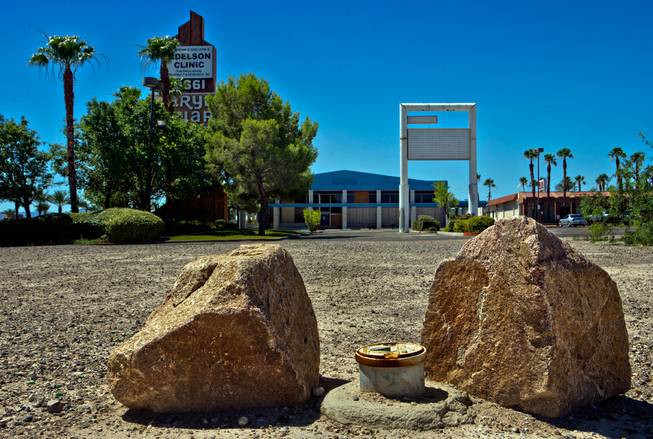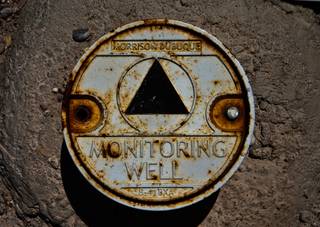
A monitoring well is shown Wednesday, June 15, 2016, near Maryland Square Shopping Center, where nearly two decades ago environmental regulators discovered a cancer-causing chemical near Boulevard Mall.
Wednesday, June 22, 2016 | 2 a.m.
Tucked behind the Boulevard mall, the Paradise Palms neighborhood is quiet on a Tuesday afternoon. Except for an occasional rooftop solar array, its mid-century homes appear unchanged since they were built in the shadow of a less developed, more desolate Las Vegas Strip. But as the residents know, looks can be deceiving.
Donna Castaneda is one of several residents in the area who wakes up each day to the fact that Paradise Palms has changed, in unseen ways that occurred below its surface. In the corner of her bedroom closet, next to her hangers, is a tube that runs from the floor to the roof, a system designed to protect her from chemicals that accumulated underneath her home.
More than 200 homes in Paradise Palms sit atop a plume created years ago by chemical spills a half-mile away at a dry-cleaning operation at the former Maryland Square Shopping Center, at Maryland Parkway and Twain Avenue. A dry-cleaning liquid known as perchloroethylene, or PCE, fortunately missed the valley’s drinking water. But the chemical bled into the groundwater, forming a plume over time that now stretches more than a mile long. The contaminated groundwater ranges from about 400 to 1,000 feet in width, and runs up to 70 feet deep in some areas. In some areas, PCE evaporated and turned into a gas, seeping into the air inside of homes.
Maryland Square is not alone. The Nevada Division of Environmental Protection keeps tabs on 40 PCE contaminations from North Las Vegas to Henderson. In most cases, the agency is confident that the chemical, a likely carcinogen that can cause health issues with long-term exposure, poses little immediate health risk to these areas.
But it is problematic enough that state regulators believe it is necessary to take proactive measures to prevent the contaminations from growing larger, posing a long-term health risk or traveling through groundwater to residential communities.
“In the absence of action, that contaminant will be there effectively in perpetuity,” said Scott Smale, who helps supervise PCE remediation efforts at the state agency.
A permanent cleanup
Compared to other plumes, Maryland Square stood out because it posed a chronic health risk to residents, requiring regulators to take action to protect the public. While they were waiting to secure funding for a large-scale cleanup, regulators addressed the risk to residents, like Castaneda, by installing free mitigation systems.
Nearly two decades since the Maryland Square spill was discovered, residents are closer to seeing that chronic health risk eliminated, an action stalled for years by litigation and a lack of funding. A plan to reduce PCE in the groundwater is in the process of being finalized, and state regulators hope to begin extracting PCE by the spring of 2017.
Among several Paradise Palms residents, the reaction is the same: It’s about time.
“This should have been taken care of,” said Castaneda, who moved to the area years before 1982, when at least one spill at the dry cleaner is believed to have occurred.
Mitigating contamination as expansive as the Maryland Square plume is costly, estimated at $5.7 million to $7.9 million. Environmental law requires regulators to obtain cleanup funds from those liable for a spill, a group that can include business owners, landlords and insurance companies. If regulators spend their own funds, they are entitled to recover costs. NDEP filed a lawsuit to do this in 2008.
A judge issued an injunction in 2010 and approved a cleanup proposal last year.
Regulators are in the process of finalizing that plan with the former owners of the Maryland Square property, who were found responsible to pay for the cleanup.
When the cleanup starts in 2017, it could take anywhere from three to 10 years to bring the concentration of PCE to safe levels, though NDEP is hopeful it will be done under the shorter time frame. The primary plan is to extract water from the plume, treat it and pump it back in, reducing the overall PCE concentration.
“I think the system we’re designing is a fairly aggressive one,” Smale said.
Lingering concerns about the spill
How the chemical got under Paradise Palms to begin with harkens to a time of looser regulations, when environmental risks associated with PCE were less known.
The plume was found to have originated from an Al Phillips the Cleaner that once operated at Maryland Square. About 100 gallons of pure PCE spilled inside the facility in 1982, according to court records, with some going directly down the drain. According to records for the site, other spills were thought to have occurred at the dry-cleaning operation and caused by maintenance or cleanouts of machines.
With the releases at Maryland Square, PCE penetrated the groundwater, traveled under Maryland Parkway past the Boulevard mall, snaked below Paradise Palms and stopped just past the Las Vegas National Golf Club. Concentrations range from undetectable to about 11,000 parts per billion closest to the site of the spills. For reference, the maximum level for safe drinking water is 5 ppb, which also is the threshold at which NDEP takes action.
One Paradise Palms resident, who asked to remain anonymous, said the plume played a role in her family's recent decision to move.
The resident, who has a 5-month-old son, now has heightened concerns about the risks posed by PCE, even though indoor-air tests showed her home was safe and she knew about the plume when she moved in five years ago. “We’re moving just to be safe,” she said.
Clark County Commissioner Chris Giunchigliani, whose district includes Paradise Palms, said she understood the concerns. She speculated that concerns might linger because PCE, as a gas, is invisible, which might make it feel more disconcerting.
“I would say (concerns) are valid because there’s the ‘What if?’” she said. “But to date, my understanding, not being in the health business, is that they are safe.”
Long-term exposure to PCE, by breathing contaminated air or coming into contact with PCE, can pose a potential health risk. PCE frequently affects the central nervous system but can also cause damage to organs like the liver or kidneys, according to the Centers for Disease Control and Prevention. The U.S. Department of Health and Human Services has said the chemical is “reasonably anticipated to be a human carcinogen.”
In determining its cleanup plans, the state environmental agency says it uses conservative standards regarding PCE’s effect on young children, a standard that is more stringent than what the Environmental Protection Agency uses in some cases. If an indoor-air test surpasses its threshold, a home gets a custom mitigation system that uses air pressure to keep PCE vapors out of a home.
Despite the underlying plume, Paradise Palms has not had issues attracting new residents. In the 2,000-foot radius surrounding Seneca Lane, which sits atop some of the highest PCE concentrations in the plume, Clark County records show about 40 residential sales in the past two years. By law, sellers are required to disclose environmental hazards, similar to disclosures for the presence of lead-based paint.
PCE contamination throughout the valley
State regulators have documented at least 40 cases of PCE plumes in the Las Vegas Valley. Over the years, the chemical, commonly used as a metal degreaser as well as a dry-cleaning solvent, made its way into groundwater or soil underlying portions of land from the Las Vegas Strip to Nellis Air Force Base. In most cases, the cause was a dry-cleaning spill. In other cases, the cause occurred so long ago it's hard to pinpoint.
Many plumes are in the process of undergoing remediation and some cases have been closed, meaning concentrations reached a certain threshold or were deemed safe. In all cases, regulators have said PCE has not affected Las Vegas’ drinking water.
But obtaining funds for remediation can be a daunting task for regulators. NDEP does not have funding to pay for cleanups and must get property owners to pay.
“There are difficulties,” Smale said. “And most of those arise from the economics.”
The Maryland Square site exemplifies what an ordeal it can be. Between 2000 and 2008, NDEP reported spending about $200,000 assessing the situation and working with property owners to engage in regular groundwater monitoring. But eight years after discovering the spill, little had been done to actually address the plume itself.
So the process turned to litigation.
The homeowners retained Alex Robertson, who filed a lawsuit on their behalf. Robertson was critical of NDEP for moving slowly and said monitoring the situation was not enough. The chemical plume needed to be addressed and remediated, he argued.
With monitoring alone, Robertson said that all regulators were doing was "taking Polaroids of a slow-moving train wreck.”
Meanwhile, NDEP had not been paid back for the money it had spent on addressing the PCE exposure. The agency also took legal action, filing another lawsuit against Al Phillips the Cleaner and a web of parties with interests in the Maryland Square land.
An injunction for remediation was secured in 2010. But that was nowhere near the end of the legal wrangling. The parties and insurance companies argued for about four years over who was responsible for paying, until a confidential settlement was reached and plans for the groundwater cleanup moved forward. The court did not approve those plans until 2015, a total of 15 years after the spill was discovered.
A lawyer for the Herman Kishner Trust, which owned the shopping center at the time of the spill, controls the cleanup funds and represents the responsible parties, did not comment on how much each party or insurance plan will pay for cleanup.
PCE contamination is not unique to Las Vegas. Several states have been forced to reckon with the solvent, and the EPA estimates that 28,000 dry cleaners still use it.
Some regulators have taken action to phase out the chemical. California’s Air Resources Board went so far as to enact a ban on PCE that goes into effect in 2023. Though industry groups oppose such bans, the EPA is requiring all dry cleaners in residential buildings, typically the smallest polluters, to stop using PCE by 2020.
In Nevada, the chemical is still legal.


Join the Discussion:
Check this out for a full explanation of our conversion to the LiveFyre commenting system and instructions on how to sign up for an account.
Full comments policy